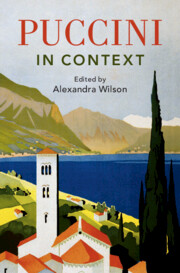Book contents
- Puccini in Context
- Composers in Context
- Puccini in Context
- Copyright page
- Contents
- Figures
- Table
- Notes on Contributors
- Preface
- Part I Formative Influences
- Part II Puccini’s Places
- Part III Influences and Interests
- Part IV Bringing Puccini to the Stage
- Part V Image and Reputation
- Part VI Puccini through a Political Lens
- Part VII Interpreting Puccini
- Chapter 26 Editing Puccini
- Chapter 27 Puccini on Video
- Chapter 28 Interpreting Puccini on Stage and on Disc
- Chapter 29 Producing Puccini Today
- Part VIII Legacy
- Bibliography
- Index
Chapter 28 - Interpreting Puccini on Stage and on Disc
from Part VII - Interpreting Puccini
Published online by Cambridge University Press: 31 August 2023
- Puccini in Context
- Composers in Context
- Puccini in Context
- Copyright page
- Contents
- Figures
- Table
- Notes on Contributors
- Preface
- Part I Formative Influences
- Part II Puccini’s Places
- Part III Influences and Interests
- Part IV Bringing Puccini to the Stage
- Part V Image and Reputation
- Part VI Puccini through a Political Lens
- Part VII Interpreting Puccini
- Chapter 26 Editing Puccini
- Chapter 27 Puccini on Video
- Chapter 28 Interpreting Puccini on Stage and on Disc
- Chapter 29 Producing Puccini Today
- Part VIII Legacy
- Bibliography
- Index
Summary
This chapter discusses the singers who have performed and recorded Puccini’s works since the mid-twentieth century. The author analyses changing trends in Puccini performance, particularly in terms of the sorts of voices that were considered most suitable for singing this repertory in audio recordings. The chapter begins with a discussion of the rivalry between Maria Callas and Renata Tebaldi, two sopranos who took quite different approaches to the performance of Puccini’s female roles. Mirella Freni and Tebaldi took a more lyrical approach than their immediate predecessors. By the 1960s and 70s – the era of the long-playing record – a new breed of international sopranos and tenors with opulent voices was emerging, including Montserrat Caballé, Luciano Pavarotti, and Placido Domingo. The 1970s and 80s was the era of the big-budget studio recording, featuring starry conductors and casts and the world’s greatest orchestras. The 1990s saw a drop-off in recordings by major labels, yet a new generation of bankable stars was emerging, including Roberto Alagna, Angela Gheorghiu, and (in the 2000s) Jonas Kaufmann. The chapter concludes with a discussion of a recent turn towards lighter voices tackling this repertory, epitomised by the success of the compelling Albanian soprano Ermonela Jaho, who brings into question the idea of what an ‘authentic’ Puccini singer might be.
- Type
- Chapter
- Information
- Puccini in Context , pp. 230 - 237Publisher: Cambridge University PressPrint publication year: 2023

